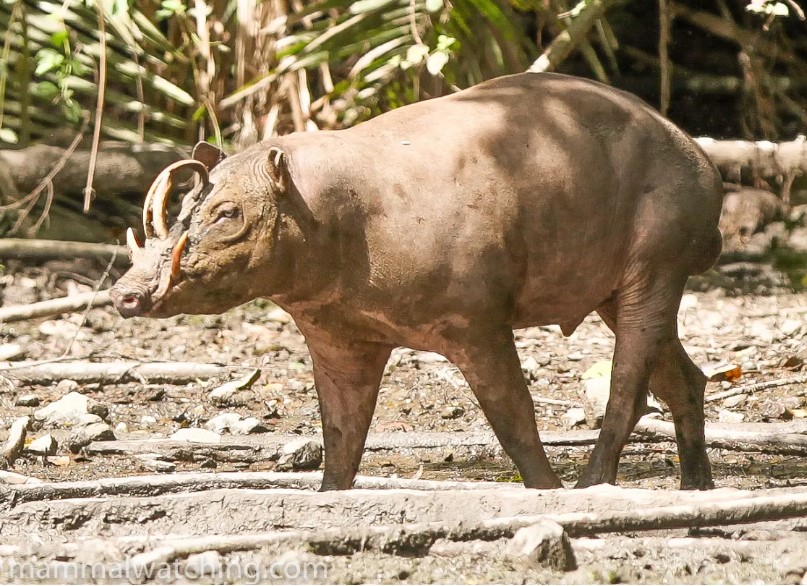
Reissued report: Sulawesi 2012
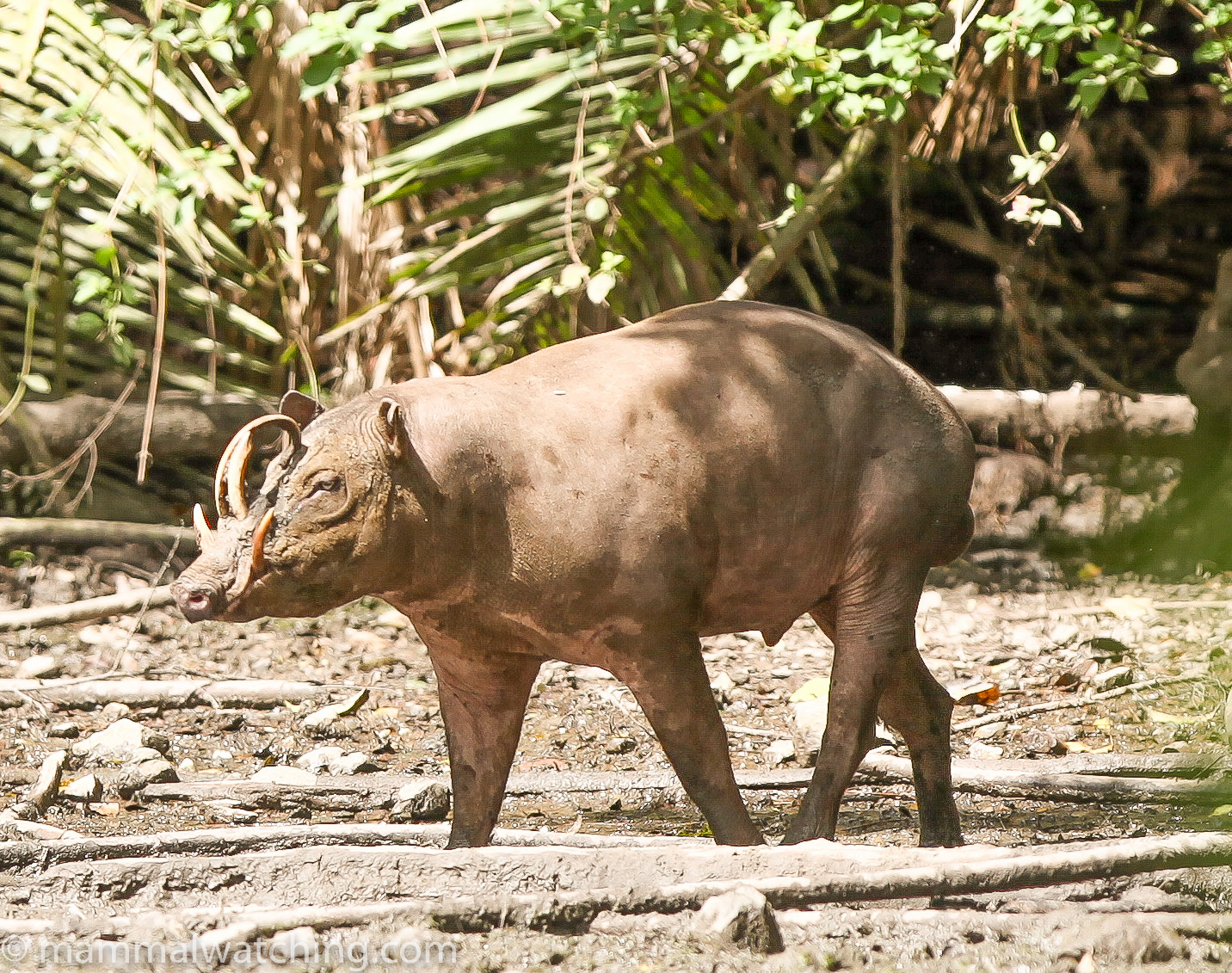
Sulawesi Babyrousa, Babyrousa celebensis
I’ve wanted to see a wild Babirusa for as long as I can remember, so when Coke Smith told me he was planning to spend Christmas 2012 mammal watching in Sulawesi it didn’t take me long to invite myself along and buy a ticket. Had I stopped to do the math I might have reconsidered: the 36 hours it takes to get from New York through Hong Kong and Jakarta to Sulawesi is a long way for just a week in the field. As is the 13 hour time change.
Nevertheless the flights worked well and I arrived into Manado airport late on Sunday 23 December where Bobby Lambaihang, who arranged the trip, was waiting for me. He dropped me at the large, comfortable, and almost completely empty, Sutan Raja Hotel, 20 minutes from the airport and arranged to meet me the following morning to drive the 2 hours to his place in Tangkoko Forest.
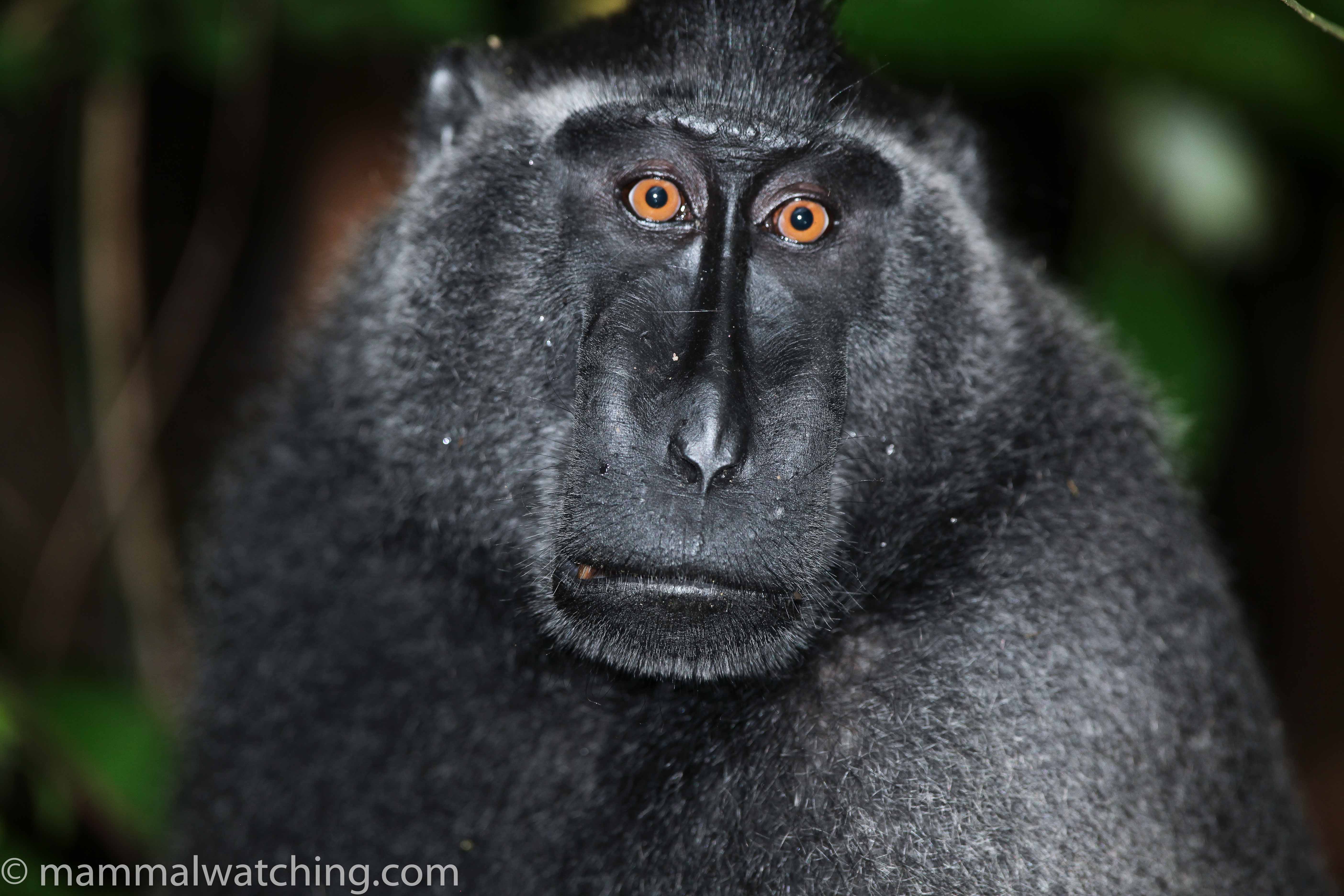
Celebes Crested Macaque, Macaca nigra
Bobby did an excellent job. He operates very much in the Indonesian style, but he knows how to get around and how to get things done. I will use him again when I return.
There are several interesting mammal sites in Sulawesi but the two standouts appear to be Tangkoko Forest near Manado, and Nantu Forest near Gorontalo. My plan was to visit both in a week. There are several other sites (islands and Lore Lindu NP for instance) that I could have visited with more time. They would doubtless have produced some more species. But my Sulawesi big 5 were Babirusa, Gursky’s Spectral Tarsier, Black Crested Macaque, Bear Cuscus and Anoa. And these all appear to be easiest to see at either Tangkoko or Nantu.
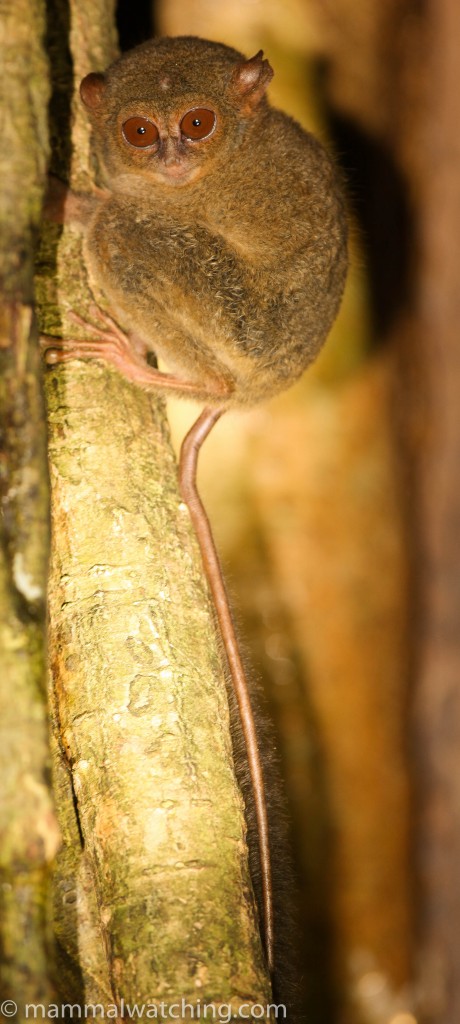
Gursky’s Spectral Tarsier, Tarsius spectrumgurskyae
I got to Bobby’s lodge at Tangkoko Forest at lunchtime in the rain on Christmas eve, after a couple of hours drive from Manado. Its a basic Asian rest house kind of a place. Its clean and friendly and surrounded by nice forest.
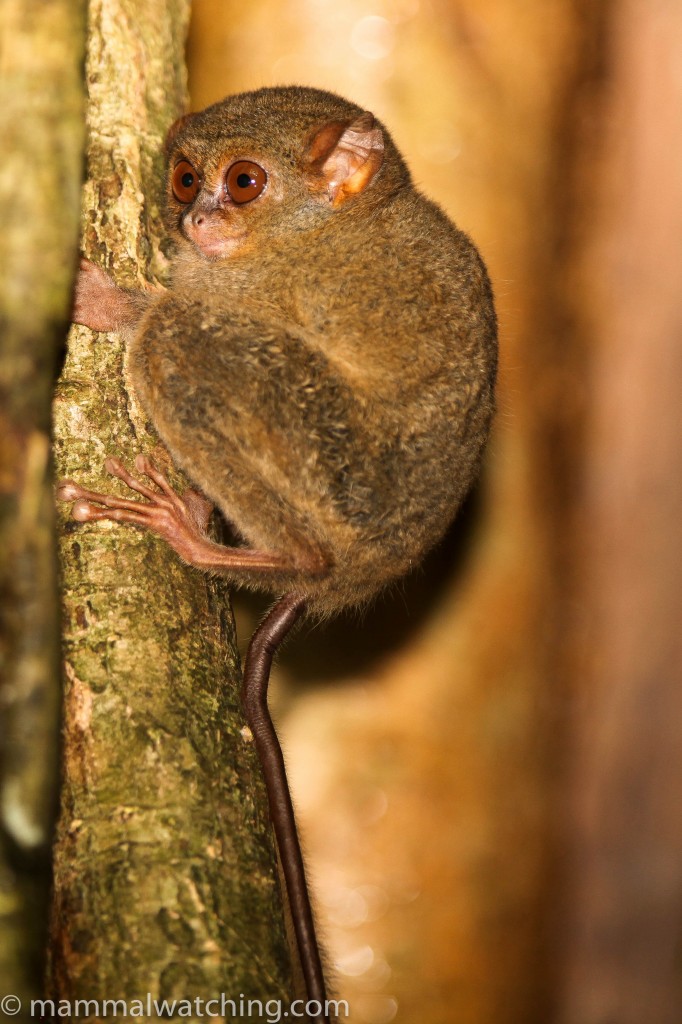
Gursky’s Spectral Tarsier, Tarsius spectrumgurskyae
Bobby recommended I use Mede as a guide, as he specialises in Cuscuses. He’s a reliable guy and a hard worker and he was good at finding me the animals I was looking for. Mede and I headed into the forest at 4pm, once the rain had eased into a drizzle. My first target at Tangkoko were the Gursky’s Spectral Tarsiers. The guides know their nest trees so its really just a matter of showing up at dusk with a torch and a few grasshoppers, which they use to tempt the Tarsiers out onto surrounding trees. We had great views of at least 2 animals that were living inside a strangler fig about an hour’s walk from Bobby’s place. Fabulous little things. We also saw a squirrel at dusk though I didn’t get a good enough look to be sure of the ID. Walking home in the dark there were many bats, and a couple of rats (I am unsure which species), though not the Sulawesi Palm Civet I was half hoping for. One had – alledgedly – been seen the previous evening near one of the rest shelters on the trail to the forest.
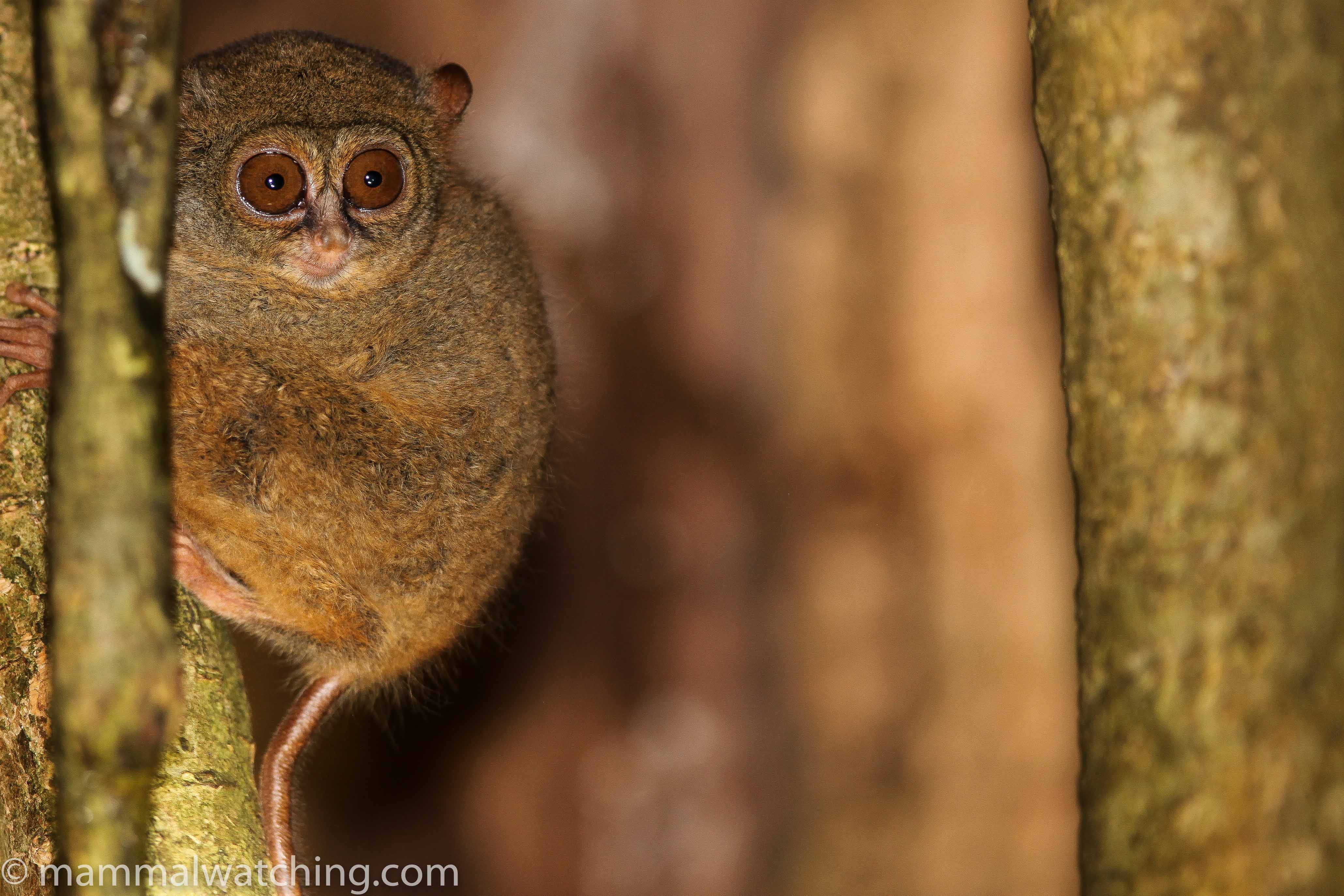
Gursky’s Spectral Tarsier, Tarsius spectrumgurskyae
After a curiously jetlag-free night, Mede and I set off at 5.30am on what was undoubtedly the least festive Christmas morning I can remember. If it wasn’t for one of the village houses blasting out a karaoke version of “White Christmas” – giving the chickens and cicadas a run for their money – I might have forgotten.
Mede found a large group of Black Crested Macaques at 7am. We heard the animals moving through the canopy and were then able to approach within a metre of a large troop on the forest floor. I could probably have gotten closer if I’d tried – they seemed totally unconcerned which I take as a very good sign about hunting pressure in the park. Either that, or someone is giving them Prozac.
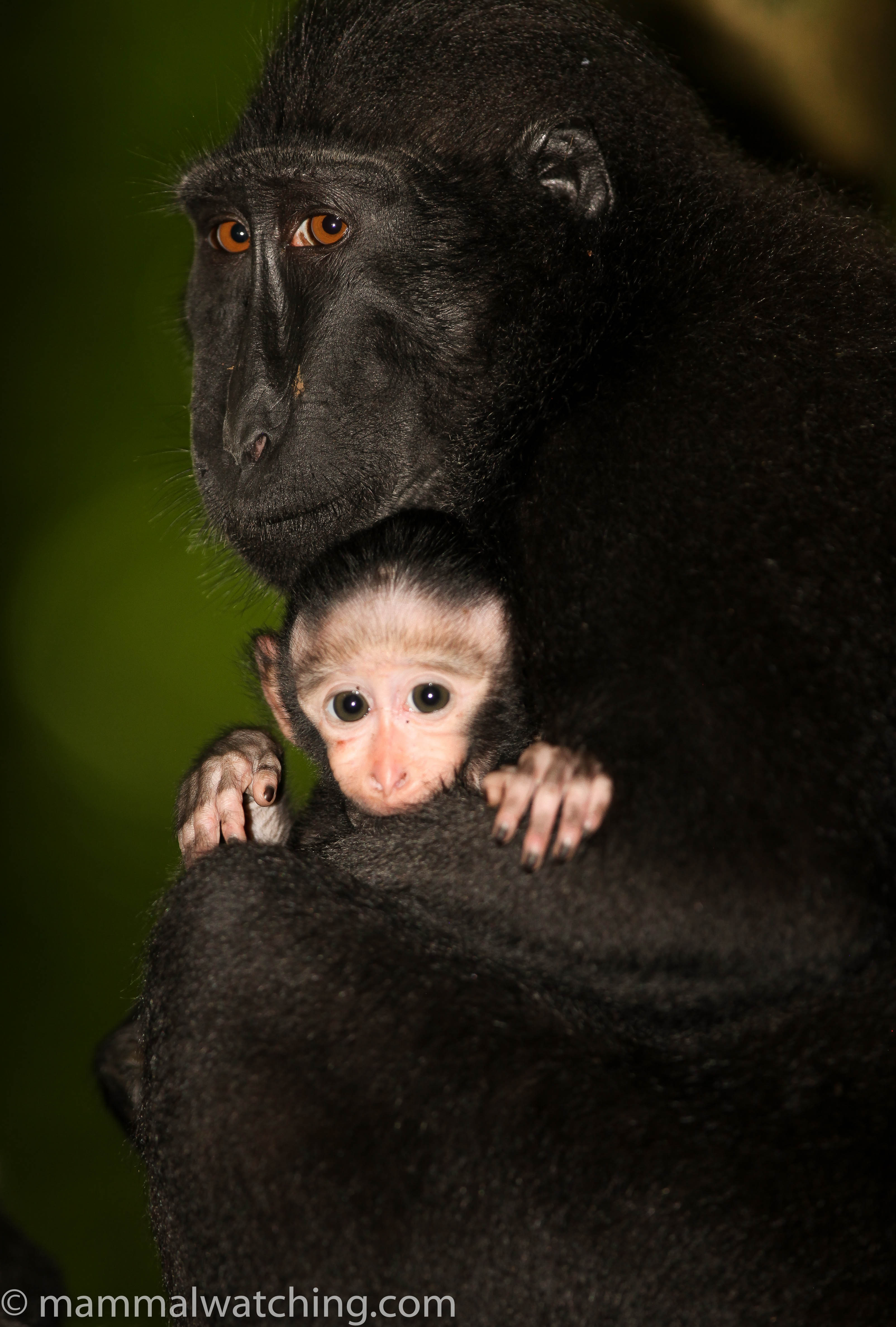
Celebes Crested Macaque, Macaca nigra
It took an hour or so to find the first Bear Cuscus. We probably passed several but their slow moving canopy habits mean they are not easy to spot.
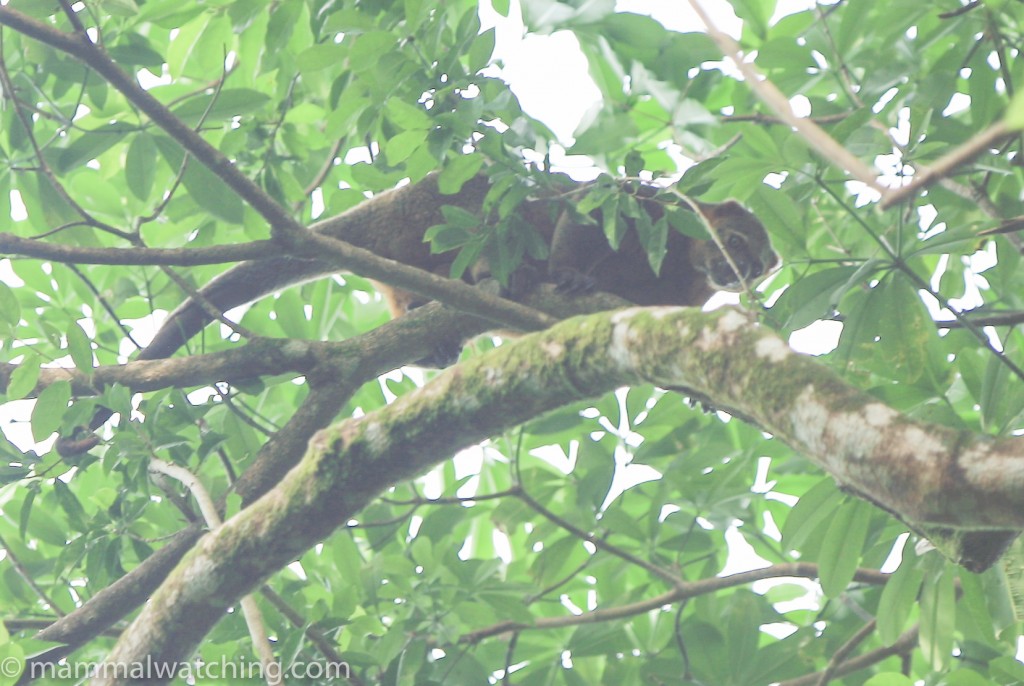
Sulawesi Bear Cuscus, Ailurops ursinus
They were larger than I had imagined with very long tails.
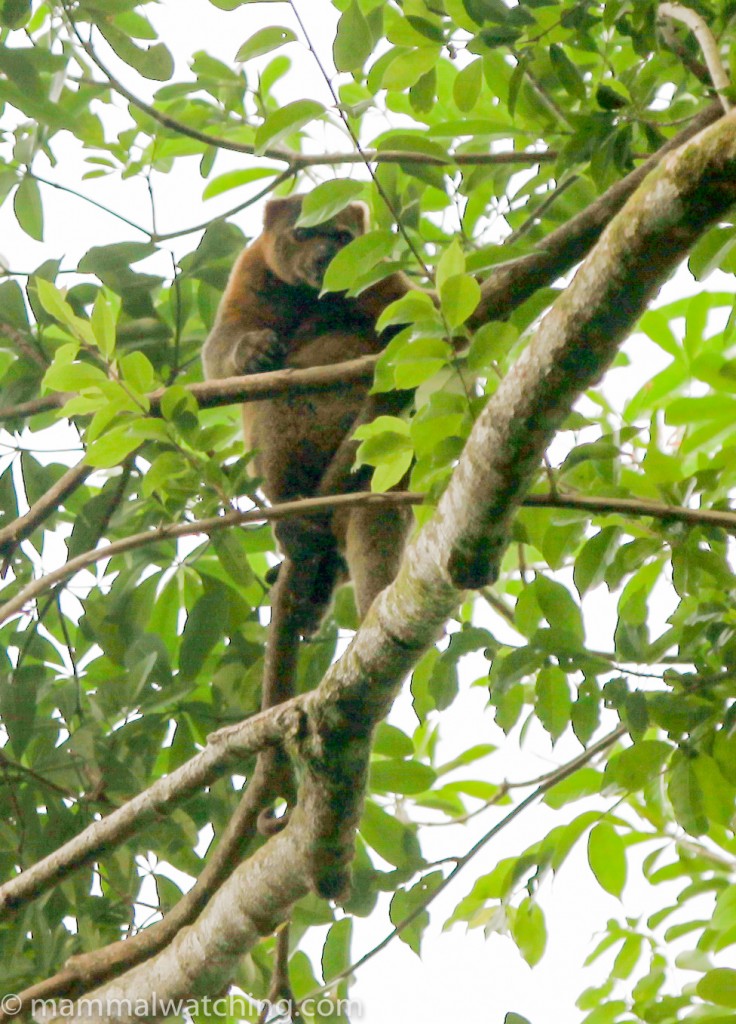
Sulawesi Bear Cuscus, Ailurops ursinus
Next stop was a hollow tree where 10 or so fruit bats were roosting. Carlos Bocos confirmed later these are Sulawesi Rousettus.
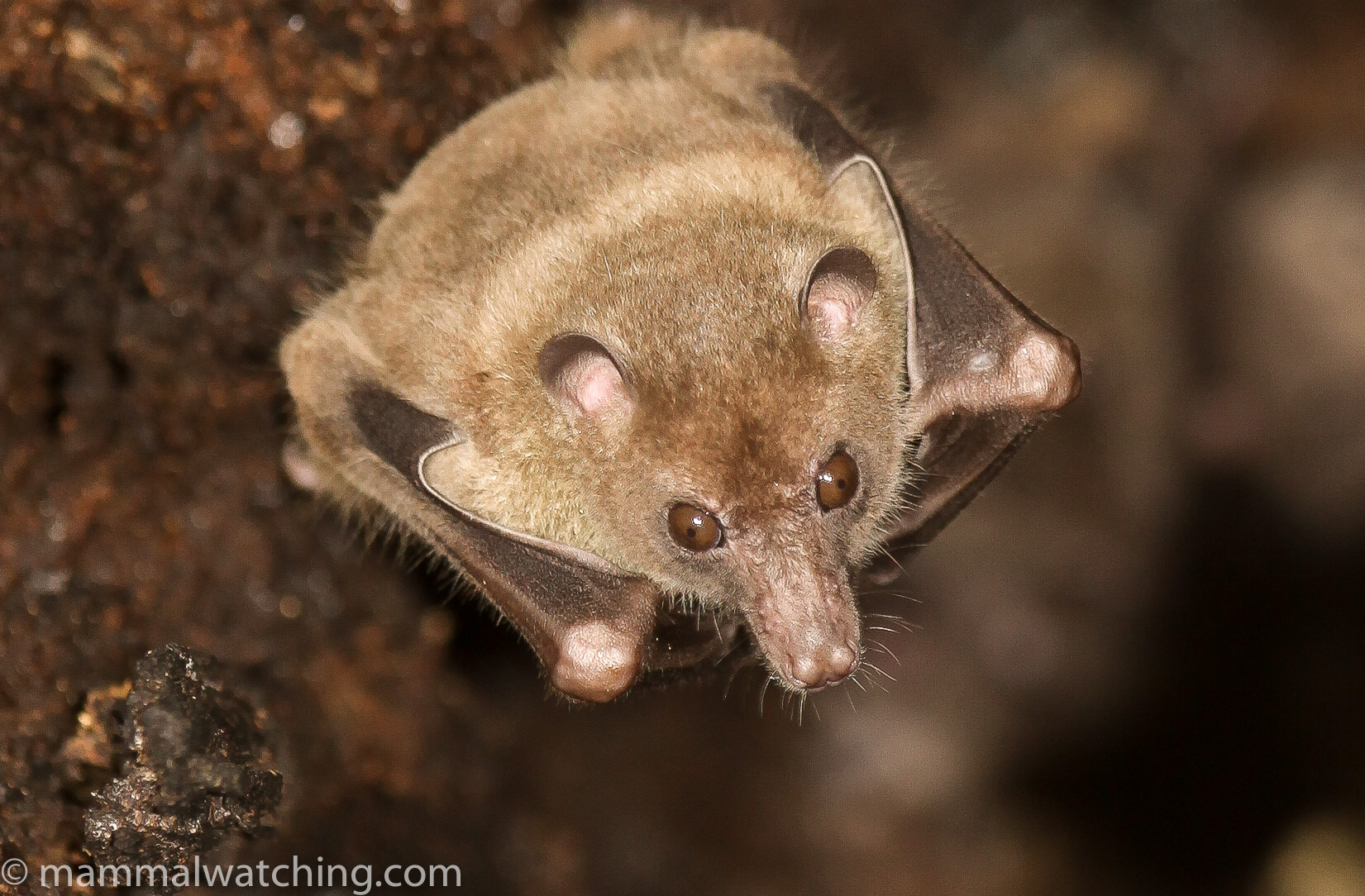
Sulawesi Rousette, Pilonycteris celebensis
On the way back to the lodge Mede heard a squirrel and we had a good view of a Whitish Dwarf Squirrel (Prosciurillus leucomus), its white nape patches and black-tufted ears clearly visible.
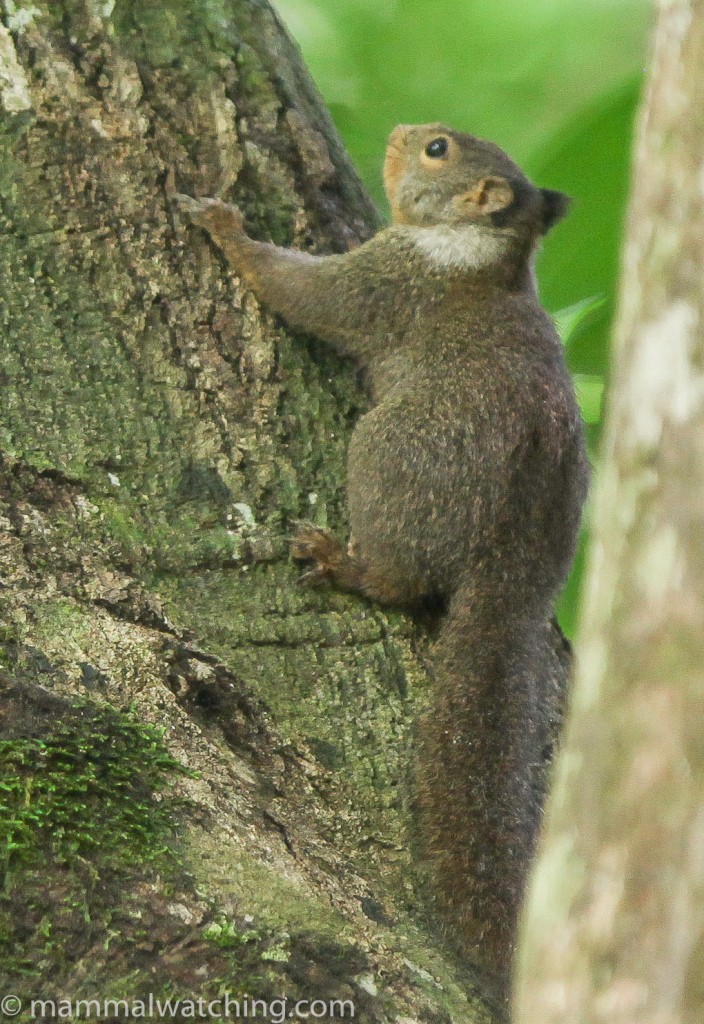
Whitish Dwarf Squirrel, Prosciurillus leucomus
Four new species before breakfast. Happy Christmas!
Not much else happened for the rest of Christmas Day. Mede and I planned to go back to the park on dusk to look for Sulawesi Palm Civets. But heavy rain from about 4pm delayed our excursion until after dinner. We set a few sherman traps in the forest and around the lodge (baited with pieces of burned coconut which Mede recommended as good rat bait). But then the rain started heavily again so I gave up on the spotlighting.
The following morning there was just one Asian House Shrew in the 20 traps.
Manado Tua
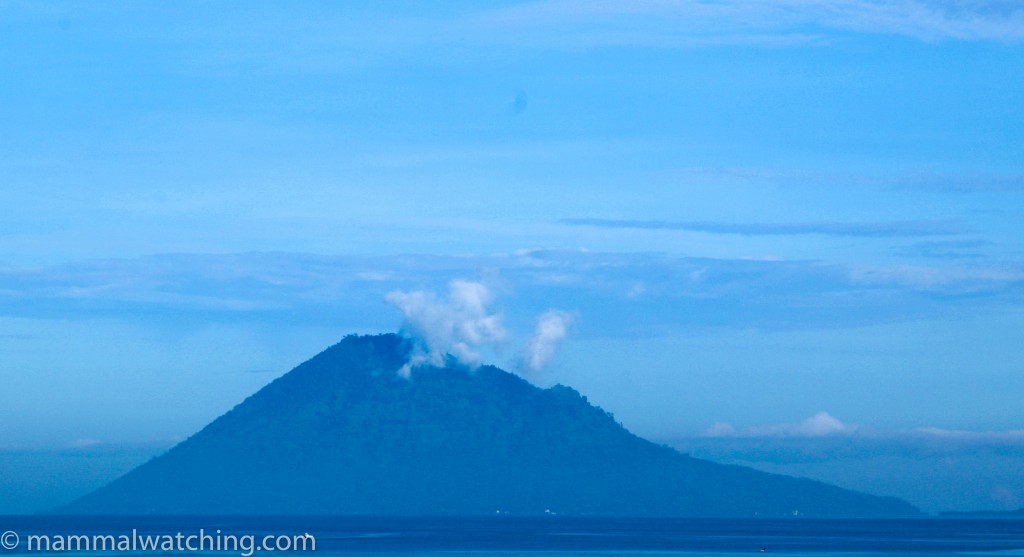
Manado Tua
Bobby and I were meeting Coke Smith and his family in Gorontalo on 28 December, so I had a day or so to kill. Rather than stay at Tangkoko I decided, on the spur of the moment, to visit Manado Tua, a small island just past Bunaken, that was rumoured to be a good place to see Dwarf Cuscuses.
The Christmas holidays made it a difficult trip to arrange. Bobby knew someone who knew someone who could arrange a homestay on the island, but he couldn’t reach him on the phone. Nor could he reach anyone who knew anyone who knew how to find a cuscus. Nor was the public ferry to Manado Tua running on Boxing Day. So Bobby hooked me up with a local boatmen who agreed to take me there and back in his speed boat for $130. I’ve no idea whether that was the going rate but it took over an hour to get there and longer on the way back so it seemed reasonable. His name is Vano Wolok, telephone +62 812 44511117. He speaks excellent English and was reliable and helpful.
When we got to the island we asked around for a Cuscus guide. A local – whose name I never got – agreed to take me. He didn’t speak a word of English and didn’t get the concept of sign language either. He spoke in Indonesian thinking I’d understand. Then said it again when I didn’t (reassuring to know its not just anglophones who do this). I’ve really got no idea of how good he was at finding Cuscuses but it quickly became obvious he wasn’t any good at guiding people to find them. The next 5 hours were about as arduous as any I’ve spent. Manado Tua is a mountain (as you can see from the photo above). We left the beach at 4pm to go straight up it. I don’t know whether my guide had much of a plan, nor whether it was possible to see Cuscuses in the day time, but we spent the next couple of hours climbing straight up to the summit. The humidity was hideous: I wrung out my tee shirt three-quarters of the way up and I reckon at least100ml of sweat trickled out. There was no trail and we were stumbling and hacking our path through vine thickets for much of the time. The ground was slippery, the soil was loose and walking across wet palm fronds was like ice skating. I lost count of how many times I fell over.
It got dark a little before 6 when we reached the summit. We spent the next 2 hours zig-zagging back down the mountain. I made so much noise however that its no surprise we saw nothing, particularly as the Cuscuses seem to be heavily hunted. In any case I was so intent on staying upright and keeping up with the guide that I didn’t have a minute to look for animals. He seemed to slow down and pay more attention in clearings, and a couple of times he started tugging on hanging vines to try to flush animals from a clump of vines in the canopy. It didn’t work. When we finished je said he had spotted an animal at one point but it fled when it heard me coming (he was usually 100 metres ahead of me, which isn’t great if you are trying to show someone an animal). I think he probably did but I will never know.
I was very happy to get back to the boat at 9pm, and well past caring about Cuscuses! At least, though, I have some information to share. There do indeed appear to be Cuscuses on the island, and with a little more time and a lot more energy than I had you might even find one. With a better trail network they would be easier to see I am sure. However, if I was to try again then I would be sure to find a decent guide, especially one who can speak at least a little English.
There are, I was told, Dwarf Cuscuses on some of the other islands. They also persist, or so Vano told me, on Bumaken but must be very scarce there. He reckoned the entire island goes out hunting them each thanksgiving day.
Nantu
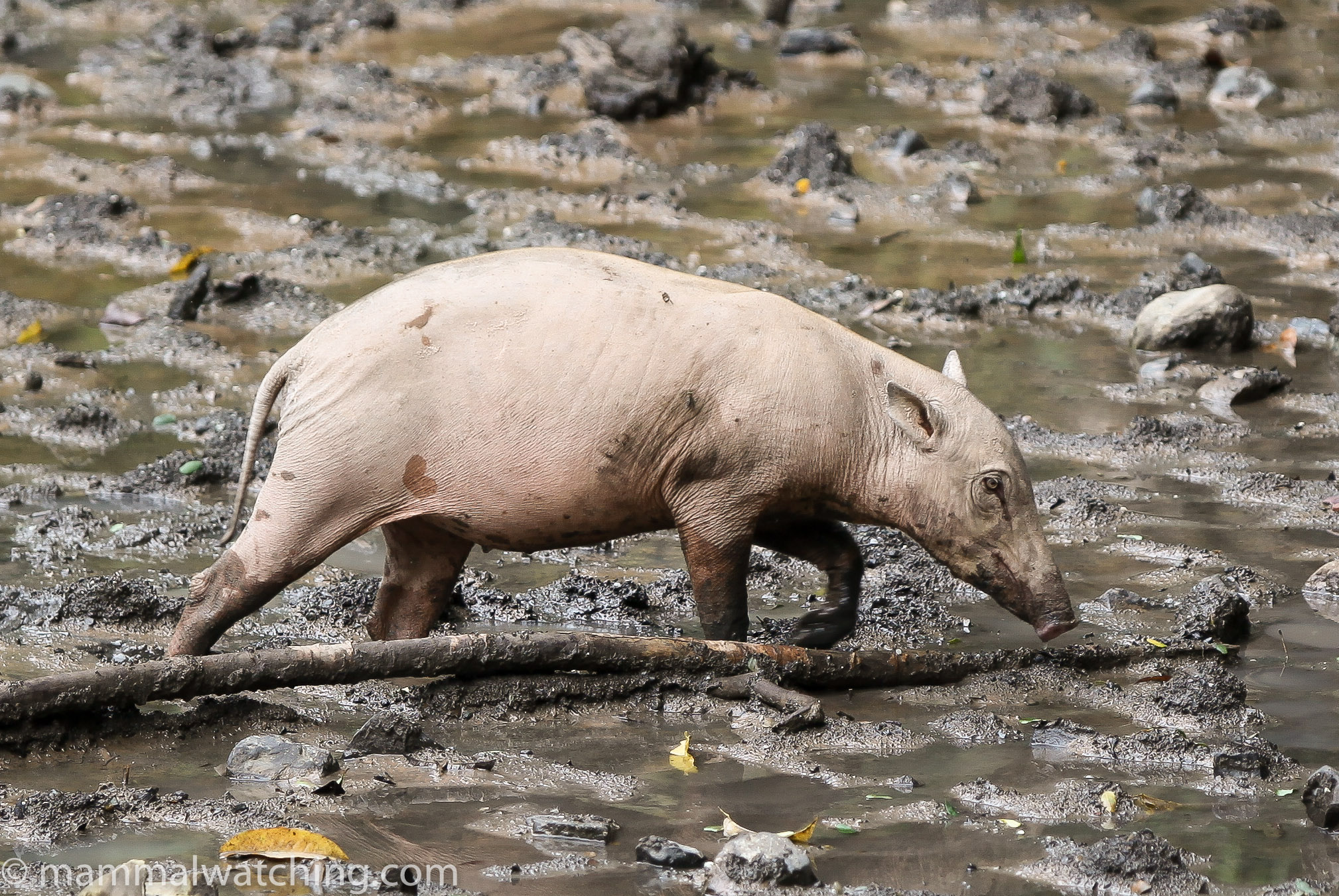
Sulawesi Babyrousa, Babyrousa celebensis
I spent the following morning searching Manado town for decent food and something to do. I found neither. Bobby met me at 1pm and we flew the 30 minutes to Gorontalo that afternoon. I was excited to be able to eat pizza there near our hotel.
It takes about 4 hours to get from Gorontalo to the Babirusas of Nantu forest. I hoped to leave as early as possible, but the local guide Bobby had contracted – Risno Hakim – had not completed the necessary paperwork. This was frustrating and Bobby said there was no excuse as the guy had known since August he had to get both police and forest department permits. He had reassured Bobby it was all “OK”. It wasn’t. So we spent the next day waiting for the guy who had to sign the forestry certificate, as he was out of the office.
“OK” was Risno’s favourite phrase with which he answered every question, despite his almost non-existent English. Yet things seldom were “OK”. the certificate was finally signed at 1500 and we left shortly after.
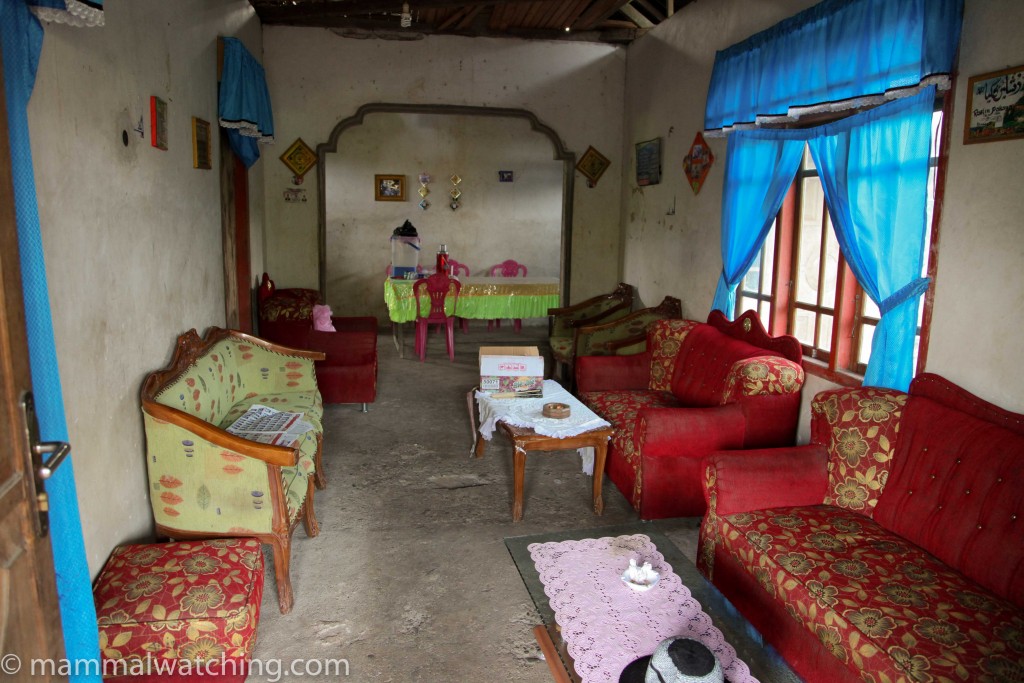
The Homestay
We arrived at the homestay at 9pm: it is very basic (without electricity and the water was from a well), but it was friendly.
Breakfast the next morning was amusing. I don’t tend to eat breakfast but, when I do, I have some breakfast boundaries (more so than with other meals). And Indonesian breakfasts are the worst I’ve come across – unless you have a thing for cold fried rice and congealed egg. I was longing for a decent coffee and one that came with real milk (most places didn’t have milk of any description, but the one hotel that had said “no problem” when I asked for milk proceeded to tip a concotion of revolting condensed milk with half a ton of sugar into my coffee).
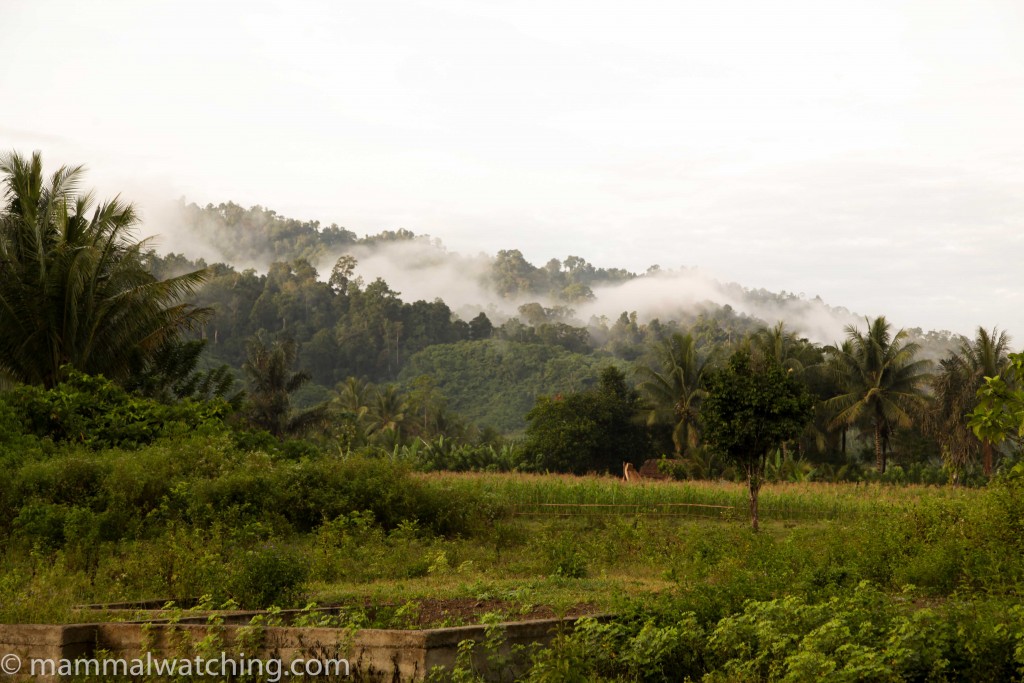
The Village, Nantu
Now breakfast that morning was a new circle of personal hell: rice with tinned sardines in tomato sauce. I’d rather have chewed my own arm off. And this was a particular problem because breakfast was also coming with me to the hide to become lunch too. So I was a pain and asked for something else. And the family were kind enough to produce some eggs after I did a passable impression of a chicken. Delighted, I scrambled up my own eggs with some chili, tomatoes and onion. Mmm mmm! I carried the pan to my plate – amidst much interest from my hosts – and the handle fell off the ancient frying pan. Breakfast was on the floor. Thankfully there was no shortage of chickens (about 1000 had been crowing all night outside my window), so they scrambled some more eggs and all was right with the world. I hope “eggs a la Jon” will become a popular breakfast dish in the village. If you try it please think of me.
It took about 45 minutes to walk to the hide – a fairly wide river at the half way mark is the park boundary which we had to wade through. The water was thigh deep but I imagine after prolonged heavy rain it would rise substantially. I didn’t see anything walking through the forest but squirrels are around for sure.
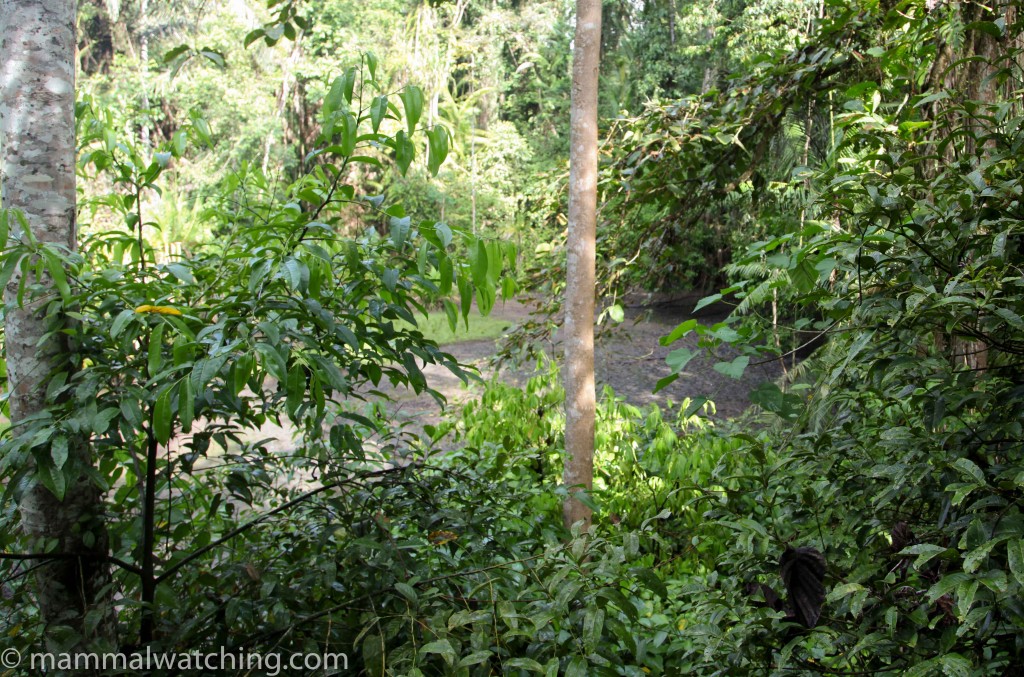
The view from the tree platform
I was left at the clearing at 8.15 and Risno promised to come back for me at 4pm. There are two hides overlooking the bai in the forest: a platform about 10 metres up a steep ladder; and a blind and ground level. Both could be a lot better with a little effort. The tower platofrm was infested with biting ants. I retreated to the blind. But the blind had windows cut at a level that could have suited a standing midget or a kneeling Harlem Globetrotter. Needless to say they were of no use to anyone in between without a seat to sit on. There was no seat.
So I went back up the tower and sprayed a circle round myself with mosquito repellent and passed time killing the ants that broke through the perimeter.
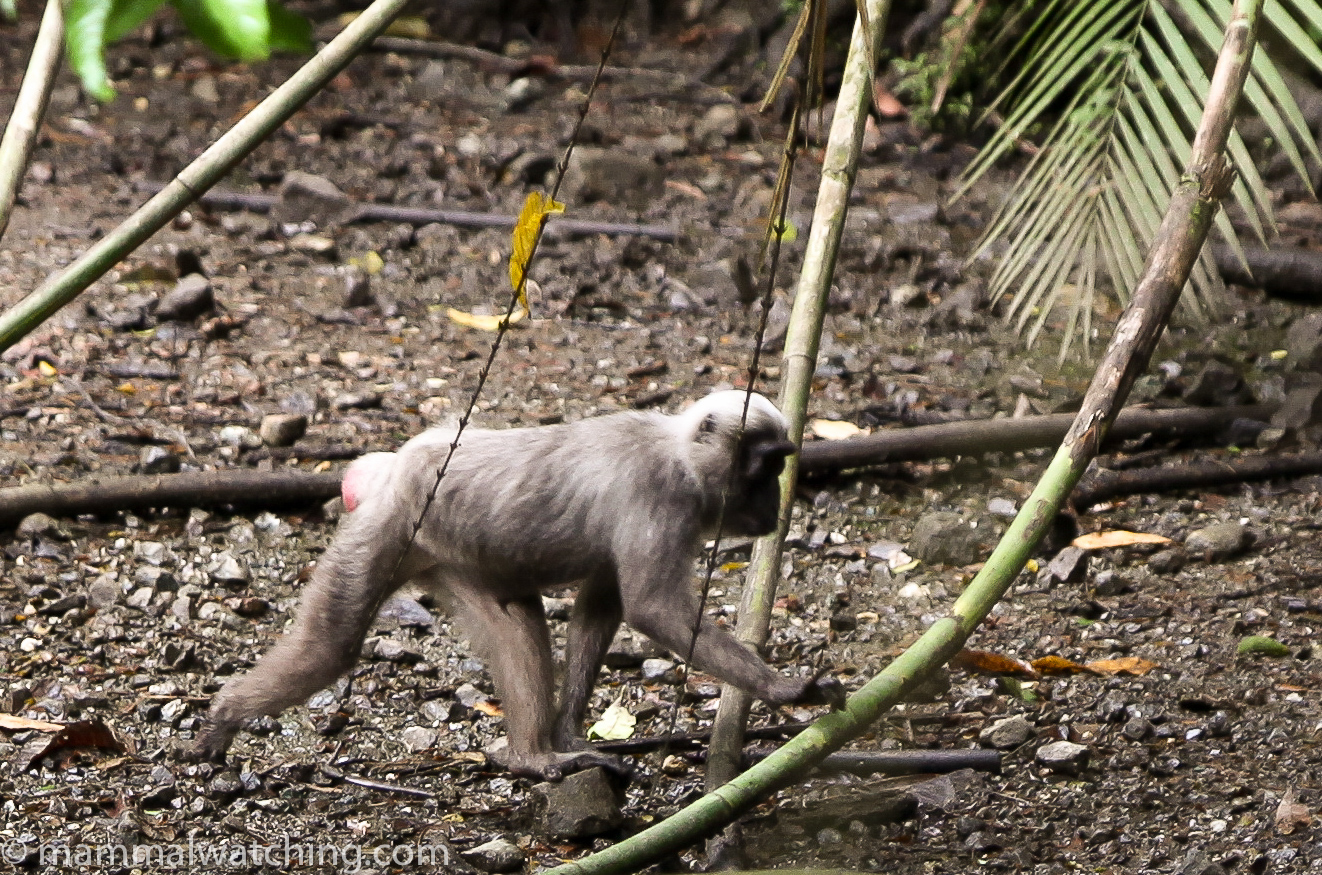
Heck’s Macaque, Macaca hecki
The mammal action began at 10am when a single Heck’s Macaque strolled through a corner of the clearing. The first Babirusas appeared immediately after and for the rest of the morning groups of females with young came and went. I saw at least 11 animals.
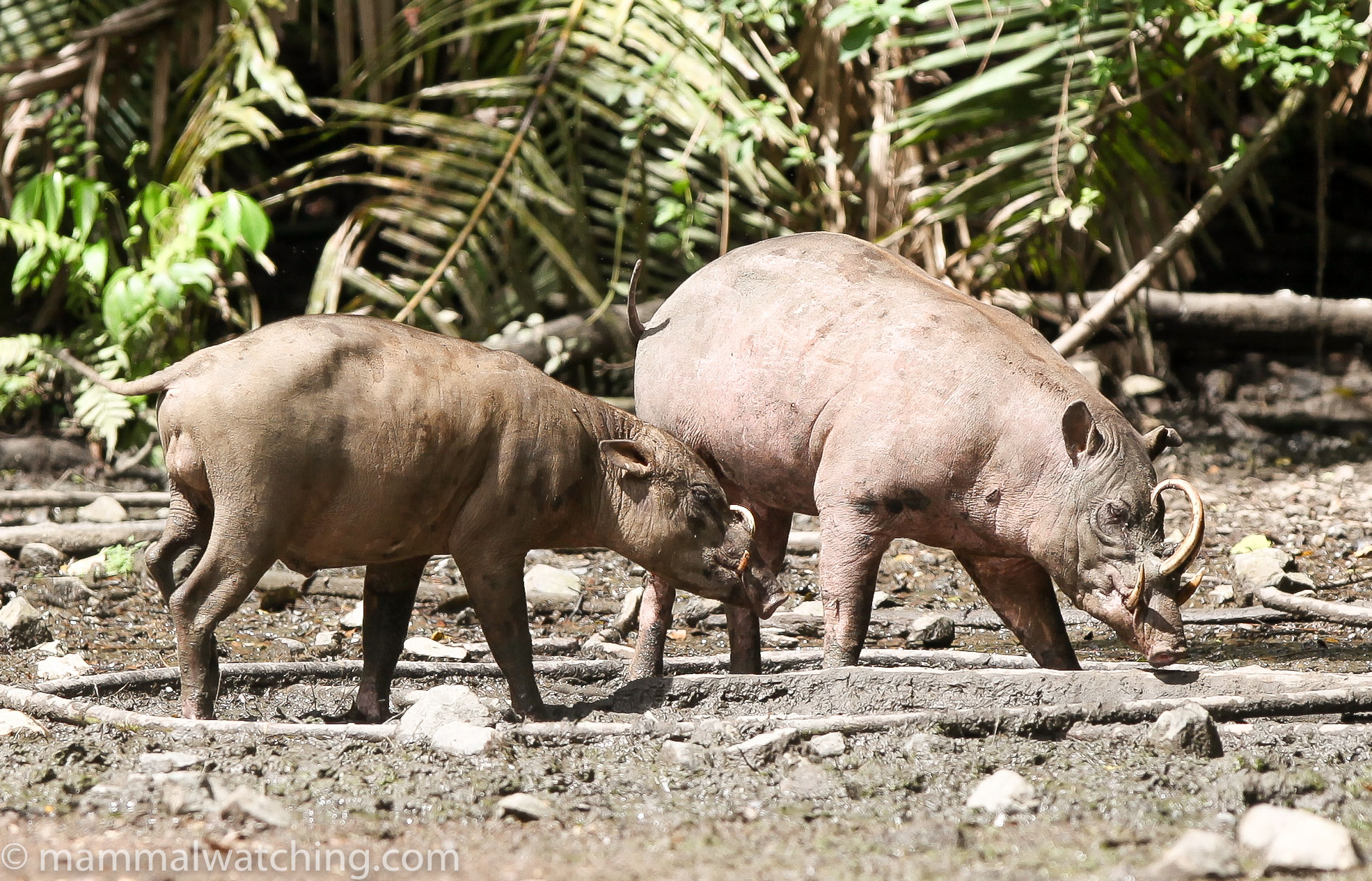
Sulawesi Babyrousa, Babyrousa celebensis
But I probably saw 60 separate sightings so the true number of individuals is between these two boundaries. The males were fewer in number and arrived later in the morning.
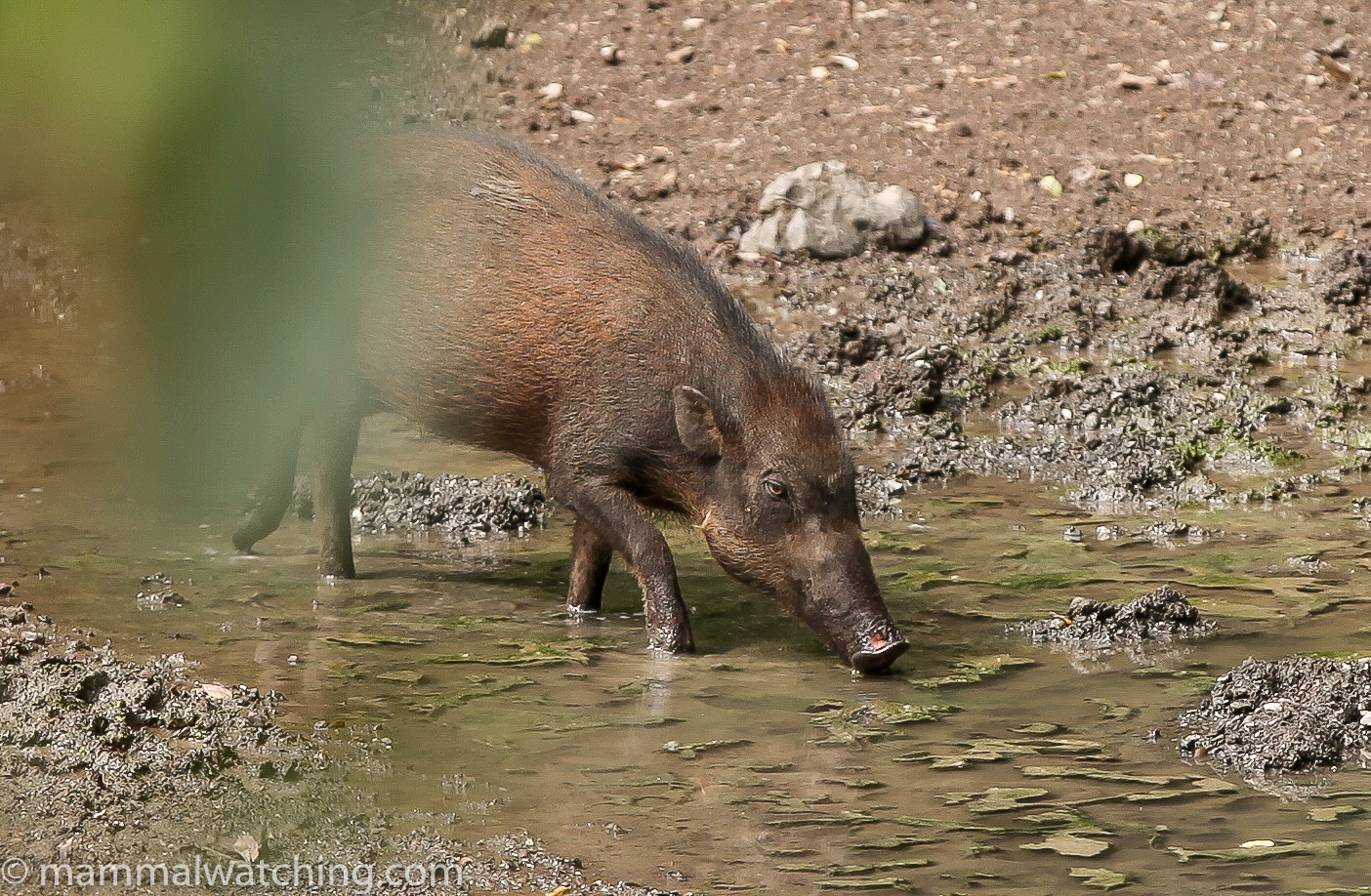
Sulawesi Warty Pig, Sus celebensis
Things slowed a little at noon for an hour or so, then the Babirusa were back followed by a couple of Sulawesi Wild Pigs at 2pm, and a troop of Macaques in the trees behind the hide at 3pm. Coke, Som and Cokie Smith arrived at 3.30 and we left the hide at 5pm and waked back – in heavy rain – to the homestay and a warm 6 pack of Bintang that Coke had imported from Jakarta.
We were back in the hide before 9am the next morning, this time with 3 plastic chairs we carried the homestay that made life a lot more comfortable. The day followed a similar pattern. A few more Heck’s Macaques (including an almost grey animal, which apparently was just old, rather than a different species), 2 sightings of Wild Pigs but fewer Babirusa than the day before. No Anoa unfortunately. Anoa are not at all uncommon there and most visitors see 1 or more during a 2 or 3 day visit it seems. I suspect I was a little unlucky and that they are more regular in the drier season (I won’t say dry season because I am not sure one exists in Sulawesi).
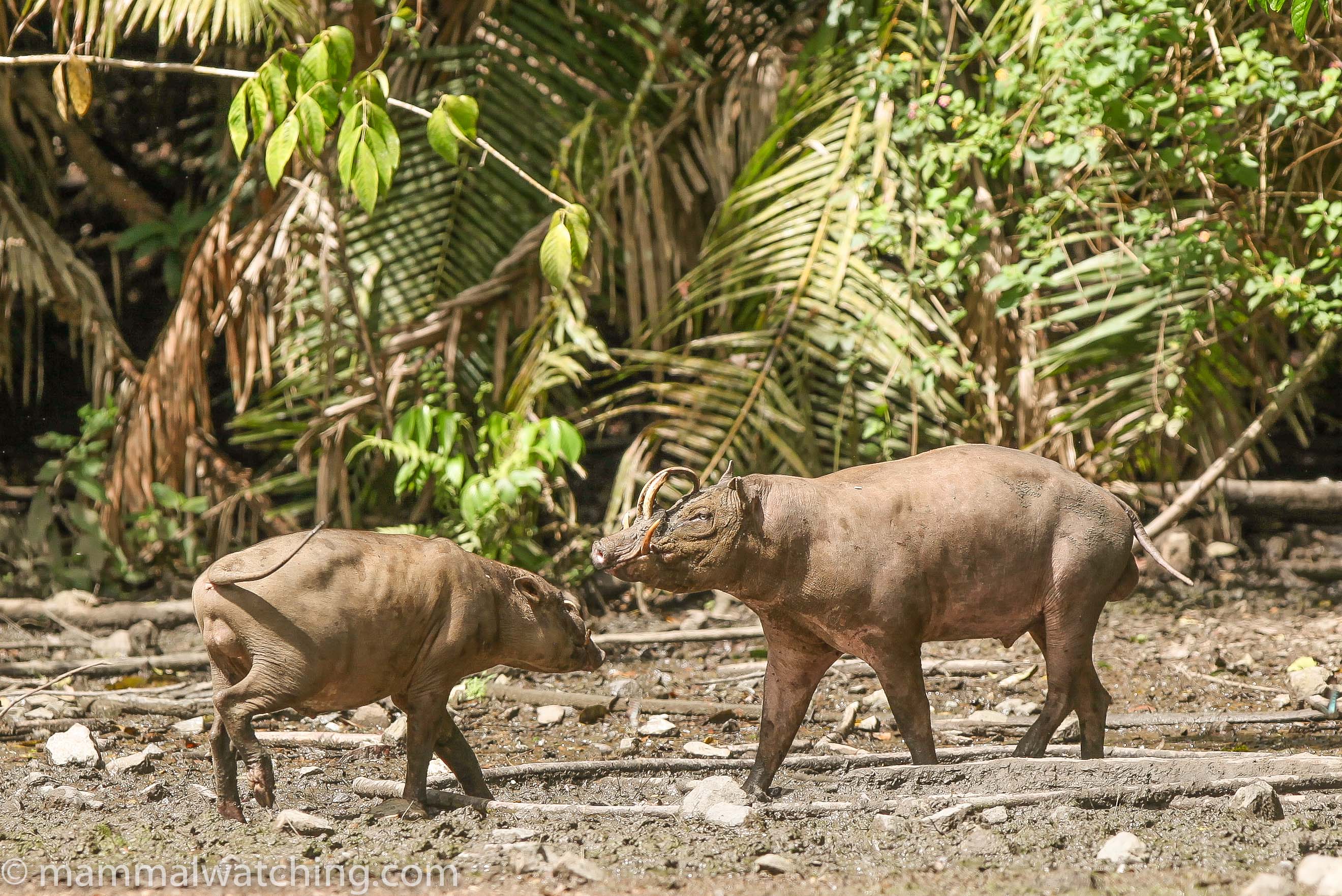
Sulawesi Babyrousa, Babyrousa celebensis
It started raining hard at 14.30 and we didn’t see any more animals until we left at 15.45.
A quick dinner at the homestay and we were back on the often flooded road to Gorontalo, the highlight of which was watching our driver ignore the road, and the spoken and signaled instructions of everyone, and try to turn our car into a submarine: he was driving through a flooded section of the road and headed straight for the swamp off the side of the road instead of turning the wheel. I have no idea what went through his mind. But afterwards he was profusely apologetic and kept saying “Sorry. Sorry. Sorry baby”.
We had a last morning to kill in Gorontalo so Bobby took Coke and I to Bogani Mani Wartabone national park to look for squirrels. The footbridge bridge into the park had collapsed and we didn’t fancy wading across the river so that was the end of that. I flew via Makassar to spend New Year’s Eve in Jakarta and then home to New York the next day.
Final Thoughts
I had a fun week. I got to see a Babirusa, one of the world’s great mammals in my opinion, along with the other species I’d expected in less than 30 hours in the field. Nine species, eight of them lifers. With better weather -and better organisation in Gorontalo -I’d probably have seen an Anoa and a couple more Squirrels too. With another week I might have added a couple more two Macaque’s, Dian’s Tarsier and a Dwarf Cuscus.
Bobby did a very good job and I’d certainly recommend him. Indonesia is not an easy country to do business in – Sulawesi especially – and he navigates it all. Mede in Tangkoko was also excellent. I’d hesitate to recommend Risno in Gorontalo, but I wouldn’t condemn him outright either, especially as I don’t know if there is anyone better. He’s a pleasant guy. Just had a different concept of time to most people. Bobby is well aware of the frustrations of trying to get prompt permits for Gorontalo and he hoped that the message has gotten through for next time Risno is involved: there doesn’t seem much excuse not to ensure it is all organised ahead of time. If you go on a hunt for Dwarf Cuscuses in Manado Tua then avoid the guy who took me out!
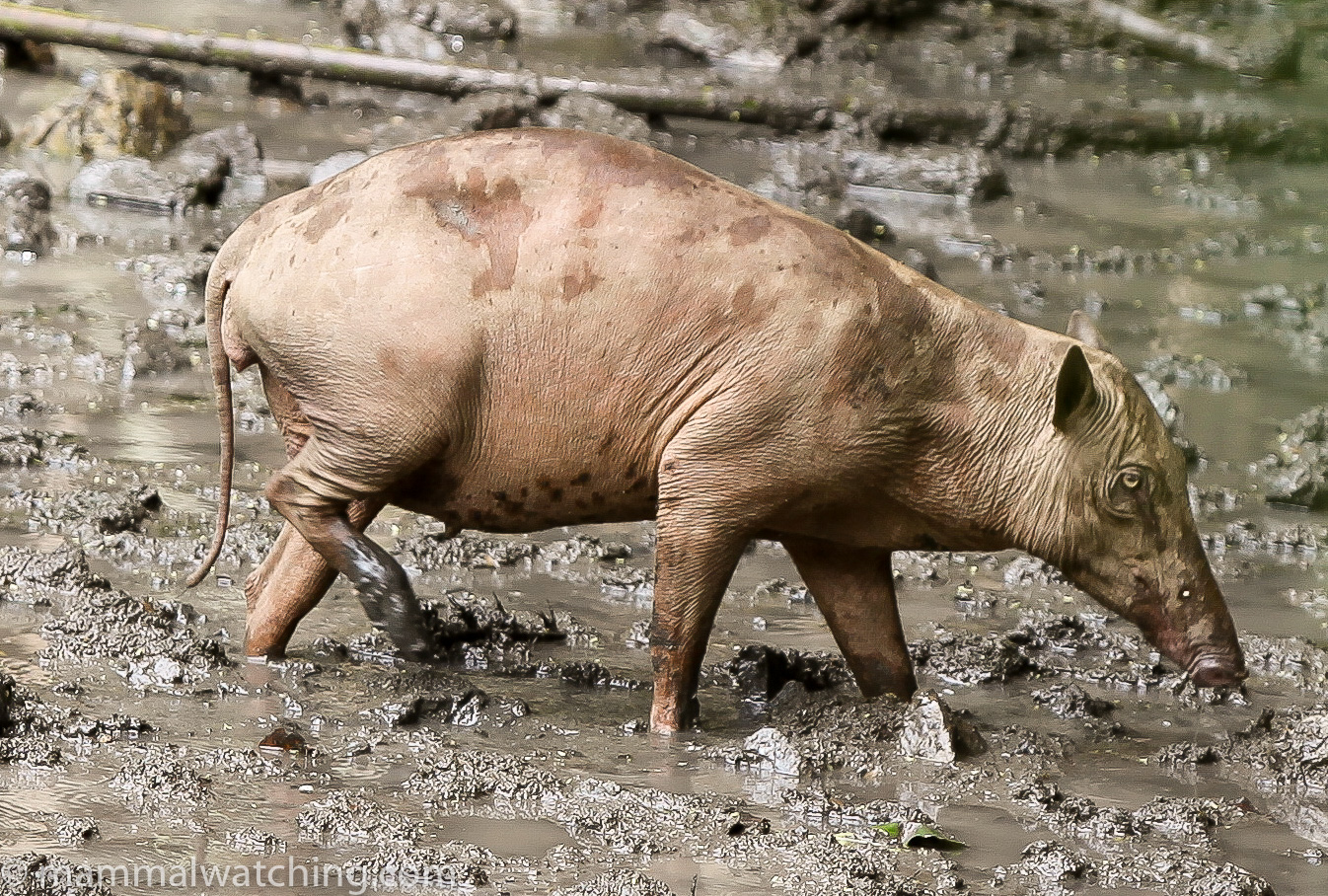
Sulawesi Babyrousa, Babyrousa celebensis
I thought Steve Anyon’s Smith report was very good on the pain and pleasure of a visit to this part of the world. I too have mixed feelings. Nearly all the people I encountered were lovely: extremely friendly and gracious and often just plain excited to see a westerner (several asked to take my picture), which is something I rarely encounter. But the inefficiency of so much about life in Indonesia , especially the corruption, is a national tragedy. The destruction of the environment is a global one. As I have never been before its hard to know at what pace the Sulawesi forest is regressing: but there seemed precious little left that was in a good state, and the national park infrastructure (I use the term loosely) was in disarray.
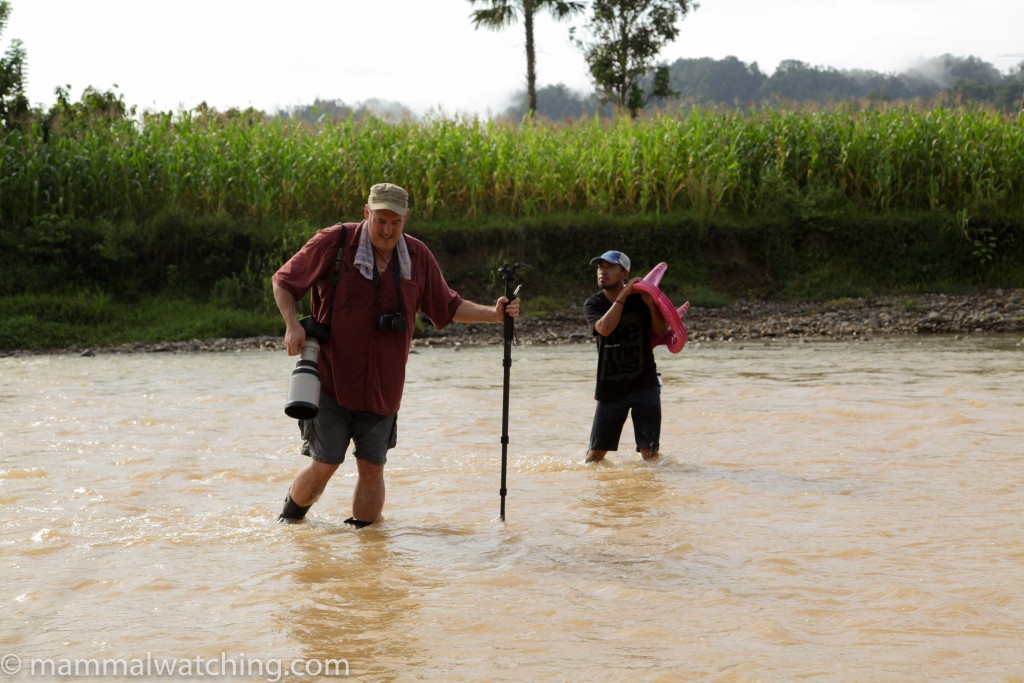
Coke Smith and his sedan chair cross the river
I can’t imagine many Indonesians care about their environment. The ignorance about wildlife (it seems extraordinary that there isn’t even a field guide to the mammals of Indonesia for example) is especially telling.
Sulawesi ought to be a cross between Thailand and Madagascar, but it lacks the food and charm of the former, and the wildlife savvyness of the latter. But I will return there one day, hopefully soon, because I still want to visit many other places. I hope that there is still some wildlife left.
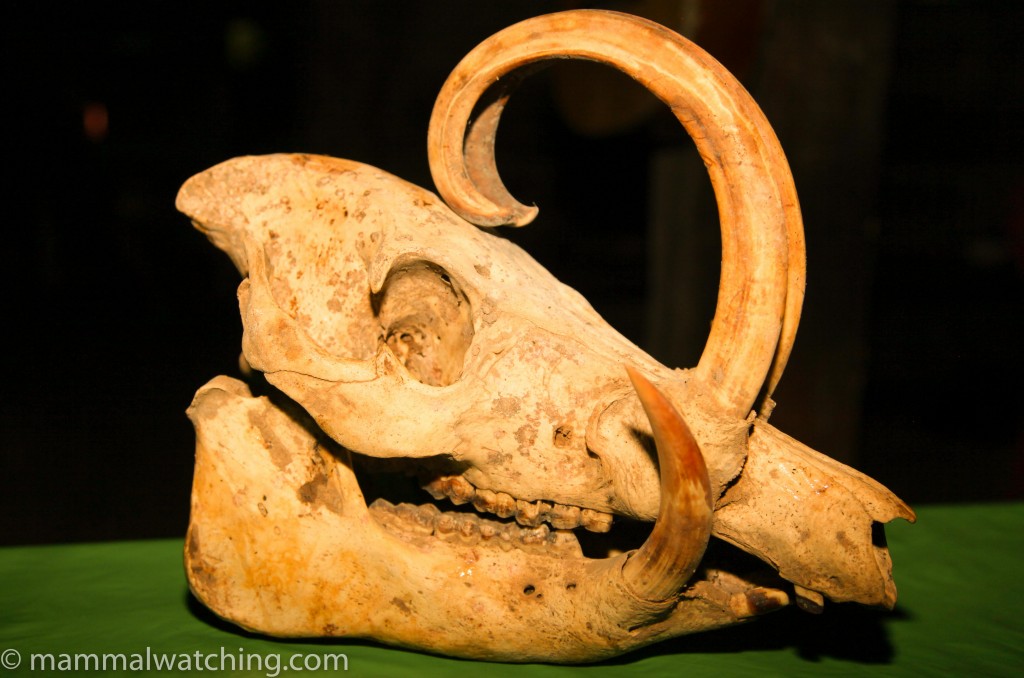
Babyrusa skull
Stuff I missed
Opinion seems divided on which other species of squirrel occur in the two parks I visited, but it sounds like two other species are probably present and quite common: Celebes Dwarf Squirrel (Prosciurillus murinus) and Sulawesi Giant Squirrel (Rubrisciurus rubriventer).
Sulawesi Palm Civets were a source of some confusion but after further discussion with Bobby do not appear to be present in Tangkoko. I assume they might be in Nantu, but its a long walk to get into the park at night and crossing the river in the dark would not be so easy. Lore Lindu park seems to offer a better chance for this species, while Dominque Brugiere saw one, years ago, in the Togean Islands.
There are also Dwarf Cuscuses at Tangkoko but they are seldom seen, probably because of their small size and canopy lifestyle, coupled with few people looking for them. Bobby has found them for photographers but usually has people looking well ahead of the photographer’s arrival to find an animal which can then be caught.
Anoas are still seen regularly at Nantu. Most of the recent trip reports I have read (mainly from the drier season) report one or two animals over a two or three day trip. I was unlucky perhaps.
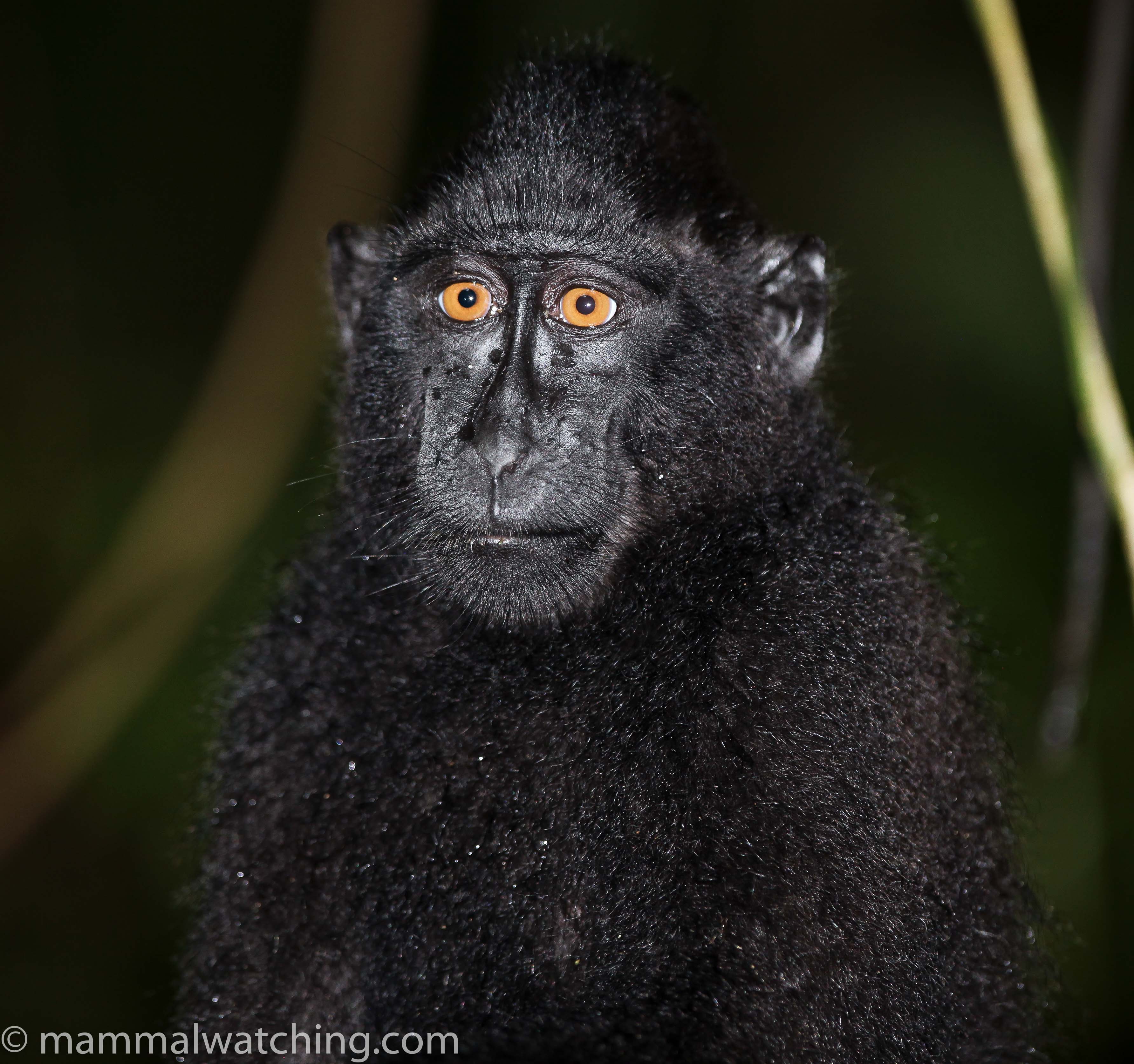
Celebes Crested Macaque, Macaca nigra


Leave a Reply
You must be logged in to post a comment.